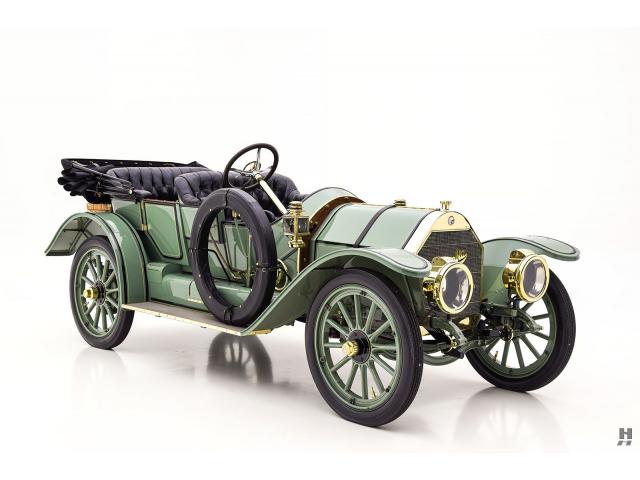1912 Columbia Cavalier Touring
- Brand: Columbia
1912 Columbia Cavalier Touring
In 1877 the Pope Manufacturing Company was founded and during its life span would produce bicycles, motorbikes, furniture, automobiles, and more. Founded by Col. Albert Pope, it is credited with many industry inventions and innovations. The Pope Manufacturing Company produced bicycles beginning in 1877 and progressed throughout the years selling various types of bicycles, tricycles, and tires. In 1894 a new office building was erected in Hartford, Ct due to increasing sales and prosperity. In 1985 Pope started purchasing his competition, buying over 70 companies and merging them into his 'American Bicycle Company'. The emergence of the automobile was beginning its slow evolution and Pope realized its potential, forming companies and building factories poised at automobile production. In 1896 an experimental automobile was created and dubbed the Mark I Phaeton Electric car. In 1987 the Mark III was developed with a price tag of around $3000, a hefty price tag at the time. Both the electric and gasoline powered automobiles were produced, most in tricycle form. The electric cars were called the Columbia and produced from 1897 through 1907 by a variety of companies in Hartford Ct.
In 1899 the Columbia Electric Coach was built for the New York City Transit used to transport dignitaries from the railroad station to city offices. The clientele list quickly expanded including many professions such as Doctors who needed transportation to and from their patient's houses.
The brochures for the vehicles guaranteed 'The vehicle were built with the best materials in the world under methods and processes more advanced than those employed in any automobile factory. No consideration of the cost of production has been permitted to interfere with making perfect every part and piece of each model, whether pertaining to mechanism, bodywork, or general equipment. The expense of making the crankshafts, for instance, is six times greater than that of any previously made in this country. We guarantee that these cars, each according to its power and place, will yield the greatest things possible in motor service.'
The Columbia Electric Carriages produced Victoria-Phaetons, Runabouts, Broughams, Landaulets, Hansoms, Surreys, Delivery Wagons and trucks.
The electric automobile was abandoned around 1906 in favor of gasoline powered automobiles. Examples include the Mark XLVII, XLVI, and XLIV-2, among others. The Columbia Mark LX electric runabout was crated by the Electric Vehicle Company of Hartford, Connecticut. It weighed about 1200 pounds and sat atop a 64 inch wheelbase. The bulk of the weight was due to the 20 two-volt cell batteries and motor. The batteries were placed under the seat producing a top speed of around fifteen miles per hour and allowing for 40 miles of total travel on a single charge.
The automotive industry was very new and the power to drive the vehicles were still being fine-tuned and experiments were still being conducted. The steam powered vehicles, such as the Stanley Steamer, offered great potential due to its quiet ride and low cost. The draw backs were that it took time to start the vehicle and the steam chambers often exploded. The electric cars were quick to start and dependable. The issues being the distance would travel before it lost its charge. The gasoline powered vehicles used a flammable source, were difficult to start, and required maintenance. As time progressed, the gasoline powered engines became the popular choice and the alternatives were no longer offered. This is true for the Columbia automobile, which closed its doors in 1912.
This 1912 Columbia Cavalier Four-Passenger Touring car is powered by a four-cylinder, 410 cubic-inch, T-head engine that can propel the 120-inch wheelbase to comfortable touring speeds, It is believed that this is the only 1912 example of the Columbia Company in existence.
Descriptions & Pictures by conceptcarz & hymanltd & planetcarsz
| Specification | |
| Production Start | 1912 |
| Country of origin | USA |




































